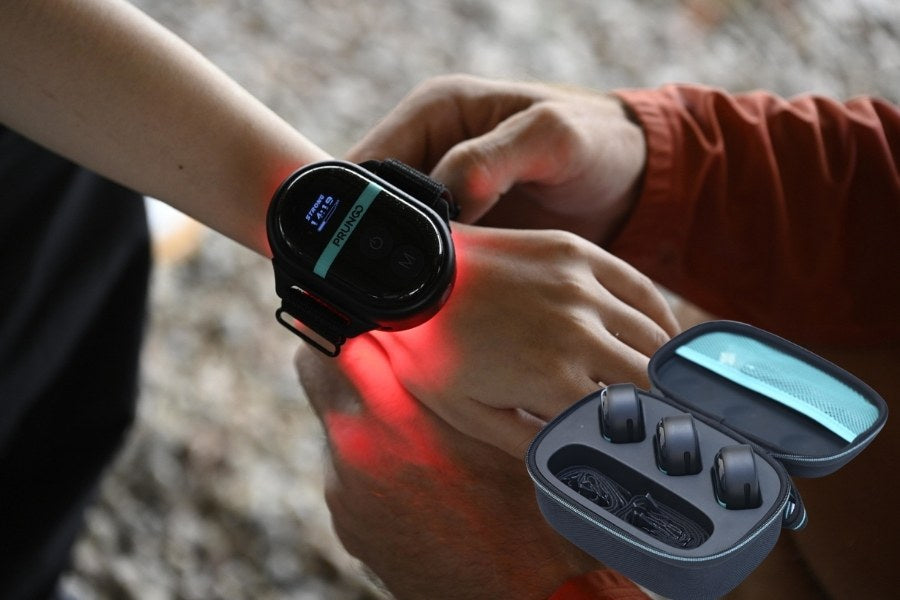Red light therapy devices and infrared therapy are common light therapies used to improve skin health, relieve pain, and promote healing. Although they may seem similar, their wavelengths and effects differ significantly.
Red light therapy uses red wavelengths in the visible spectrum to penetrate the skin's surface to promote cell regeneration and collagen production. In contrast, infrared therapy uses invisible infrared wavelengths to penetrate deep tissues and joints to relieve inflammation and improve circulation.
In this article, we'll explore the key differences between red and infrared light therapy, how they work, their benefits, and how to choose between them based on your health goals.
What is Red Light Therapy?

Red light therapy is a treatment method that uses red light with wavelengths between approximately 620 and 850 nanometers in the visible spectrum. Red light penetrates the skin at a relatively shallow depth, typically 2 to 3 millimeters.
It accelerates wound healing, reduces inflammation, improves skin health, and reduces pain by penetrating the surface layers of the skin and stimulating mitochondrial activity in cells, promoting energy production and cellular repair. Red light therapy is often used to treat issues closer to the surface of the skin, such as:
- Skin health and rejuvenation (e.g., wrinkle and fine line reduction)
- Wound healing and tissue repair
- Stimulation of hair growth
- Reduced inflammation in surface tissues
The key to the effectiveness of red light therapy lies in how it interacts with the mitochondria in cells. Red light is absorbed by the skin and stimulates mitochondrial activity, which increases the production of adenosine triphosphate (ATP), the energy currency of the cell.
FDA-approved red light therapy benefits are because these increases in energy enhance the cellular repair process, promote collagen production, and reduce inflammation, all of which aid in tissue recovery and healing.
What is Infrared Light Therapy?
Infrared light therapy (ILT) uses near-infrared (NIR) light with a longer wavelength than red light, typically between 700 and 1000 nm. Unlike red light, infrared light is invisible to the human eye and can penetrate the body more deeply—up, up to 5 to 10 cm (about 2 to 4 inches).
Because infrared light penetrates deep into skin and muscle tissue, reaching deep joints and organs, the therapy can improve circulation, relieve pain, reduce inflammation, and speed up tissue repair. This deeper penetration of infrared light therapy makes infrared light therapy more effective for addressing the following issues:
- Deep tissue healing and muscle recovery
- Joint pain and inflammation caused by conditions such as arthritis
- Bone health and repair
- Chronic pain relief
- Neuropathy and nerve repair
Similar to FDA-approved red light therapy, infrared light therapy works by boosting ATP production, but because infrared light can reach deeper tissues, it can affect muscles, bones, and even nerves.
This makes it a very effective treatment for pain relief and recovery from injuries that are not limited to the surface of the skin.
Main Differences Between Red Light and Infrared Light Therapy
Both FDA-approved red light therapy and infrared light therapy enhance cellular function by producing ATP, helping us relieve pain and other problems.
However, there are some differences between red light therapy and infrared light therapy in wavelength, penetration depth, and therapeutic applications.
1. Wavelength and Visibility

Red light therapy uses wavelengths in the 620-850 nm range, which are visible to the human eye. When used, the light appears red and is easily absorbed by the skin's surface.
In contrast, infrared light therapy uses near-infrared light with a wavelength range of 700 to 1000 nm. These wavelengths are invisible and may not produce any visible glow when the light hits the skin.
2. Depth of Penetration
Red light can penetrate the skin 2-3 mm, making it suitable for treating conditions that affect the surface of the skin or just below the skin, such as acne, wrinkles, and mild inflammation.
Infrared light can penetrate 5-10 cm and reach deeper layers of the body, including muscles, joints, and even bones. This makes it more suitable for treating muscle soreness, joint pain, and inflammation such as arthritis.
3. Targeted Conditions
Red light therapy is primarily targeted at superficial conditions, especially skin health issues, and is often used for:
- Anti-aging: Promotes collagen production, improves skin elasticity, and reduces wrinkles.
- Wound healing: Accelerates the healing of epidermal wounds and scars.
- Acne treatment: Reduces inflammation and bacteria, helping to treat acne.
- Hair growth: Stimulates hair follicles and promotes hair regrowth in patients with hair loss.
Infrared light therapy is more suitable for deep tissue healing and pain management and is often used for:
- Chronic pain: Relieves arthritis, fibromyalgia, and sciatica.
- Muscle recovery: Promotes blood flow and reduces deep muscle inflammation.
- Joint and bone health: Helps relieve joint pain and may help improve bone density and heal fractures.
4. Therapeutic Applications
Red light therapy is commonly used for skin beauty, anti-aging, treatment of acne and mild inflammation, etc.; infrared light therapy is widely used in physical therapy, relief of deep muscle and joint pain, recovery from sports injuries, etc.
Shared Benefits of Red and Infrared Light Therapy
Despite their differences, red and infrared light therapy both share some common benefits. Both light therapies are non-invasive, safe for most users, and help heal on a cellular level. Here are some of the benefits they share:
- Pain Relief:Both therapies reduce pain and inflammation, with red light therapy being useful for superficial issues, while infrared light therapy is more effective for deep tissue pain, such as joint pain and muscle soreness.
- Increase Circulation:Both boost blood flow and improve oxygen and nutrient delivery to targeted areas, helping to speed recovery and reduce inflammation.
- Cell Repair and Regeneration:By increasing ATP production, and promoting cell repair and regeneration, it speeds up the healing of superficial wounds and deep tissue injuries.
- Non-Invasive and Safe:Light therapy is non-invasive, has few side effects, and requires no recovery time, making it an ideal choice for alternative pain relief and tissue healing.
How to Choose Between Red Light Therapy and Infrared Light Therapy

Before deciding whether to choose red light therapy or infrared light therapy, you should base your decision on your physical health goals and the parts of your body that need to be treated. Here are some considerations:
- If your primary concern is skin health, including issues such as acne, wrinkles, or minor wounds, red light therapy is your best choice.
- If you are dealing with muscle soreness, chronic joint pain, or deep tissue injuries, infrared light therapy is a more effective option because it can reach deeper into the body.
- For athletes or individuals recovering from strenuous physical activity, infrared light therapy can help speed muscle recovery and reduce soreness.
Some red light therapy devices combine red and infrared light therapy, offering the benefits of both treatments. These devices allow you to target both superficial and deep tissue conditions, making them a versatile option for a variety of needs.
For example, the PRUNGO Red Light Therapy Device combines two light therapy modalities. The PRUNGO medical-grade red light therapy devices are equipped with 3 modules with a total of 30 advanced LED lights. Each module contains 6 650nm red light LEDs and 4 850nm infrared light LEDs.
This combination utilizes the shallow healing power of red light and the deep penetrating effects of infrared light, through proprietary polarized light technology, to provide superior penetration depth, resulting in faster and more significant treatment results for many health needs.
Related reading: Is red light therapy safe during pregnancy?
















Share:
7 Useful Gifts for Parents On Black Friday
HOOGA VS PRUNGO Red Light Therapy: The Different